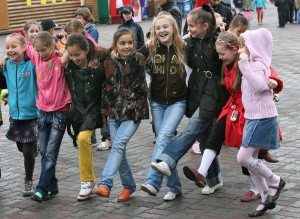 Keeping children on track requires effort. Some years ago, I was the teacher of a lovely class of Year 3 children. They worked well together, had a great work ethic and were very nice little people individually, many of whom I remember to this day. Towards the end of the spring term, the school was asked to take some students for teaching practise. In the hands of someone without experience and with insufficient planning and preparation, I witnessed my ‘lovely class of Year 3 children’ not only riot but individually behave in ways they wouldn’t dream of behaving normally. Consequently, I was forced to step in to stop the lesson when it became dangerous for the children because they were out of control. I didn’t speak, it wasn’t necessary. I just stood in the classroom doorway where they could see me and it all calmed down to silence. This is what a group of children are capable of doing when there is no structure and no boundaries.
Keeping children on track requires effort. Some years ago, I was the teacher of a lovely class of Year 3 children. They worked well together, had a great work ethic and were very nice little people individually, many of whom I remember to this day. Towards the end of the spring term, the school was asked to take some students for teaching practise. In the hands of someone without experience and with insufficient planning and preparation, I witnessed my ‘lovely class of Year 3 children’ not only riot but individually behave in ways they wouldn’t dream of behaving normally. Consequently, I was forced to step in to stop the lesson when it became dangerous for the children because they were out of control. I didn’t speak, it wasn’t necessary. I just stood in the classroom doorway where they could see me and it all calmed down to silence. This is what a group of children are capable of doing when there is no structure and no boundaries.
Keeping children on track requires Boundaries and structure
That is an extreme example, but it is worthy of note because it shows how important structure is to a child who is in the process of developing their own, internal boundaries. Boundaries and structure represent an important part of the parent role in protecting the child while they develop. It is unfair to expect highly creative, sensitive, reactive, intelligent little people to ‘behave’ and exercise ‘self control’ and ‘self discipline’, when there is so much in the this world that encourages the opposite! The ‘rules’ of the 21st century are not intuitive, they are about the culture we live in and not about our growth and development, which is why they need to be learned and do not come ‘naturally’.
Routine and structure
The school day helps in keeping children on track by offering them routine and structure. They know what the expectations are and what is needed from them. When this is abandoned in the holiday, they may stay in bed longer than is needed and apart from becoming grumpy, cause interruption to everyone else’s routine; they may be mesmerised by computer games and tv, causing the brain to race and trigger irritation in them; develop ‘attitude’ about any homework you ask them to do and refuse to help around the house. If this happens in your home – or if you worry that it might – I recommend you develop a holiday structure and timetable. It can be whatever you want it to be in terms of timing and expectations.
 Keeping children on track may involve wanting them to read once a day; to get up and make their beds; tidy up; help with shopping and so on as well as ‘time off’. It really helps to sit down with the children before the school holiday and decide a holiday routine that everyone can agree will work for them. Keeping children on track can include fun things as well as responsibilities so that the children know that (for example), after they’re up and dressed, they can have an hour free before reading or going out. Include play dates and and set holiday bed and getting up times to maintain a routine, which reduces stress and anxiety.
Keeping children on track may involve wanting them to read once a day; to get up and make their beds; tidy up; help with shopping and so on as well as ‘time off’. It really helps to sit down with the children before the school holiday and decide a holiday routine that everyone can agree will work for them. Keeping children on track can include fun things as well as responsibilities so that the children know that (for example), after they’re up and dressed, they can have an hour free before reading or going out. Include play dates and and set holiday bed and getting up times to maintain a routine, which reduces stress and anxiety.
Timetable
Write up a timetable where everyone can see it and tick it as you go. It doesn’t need to be set in stone; it is your tool to help you to get the most out of the holiday period at the same time teaching your children to value time.
Preparation
The more thorough the preparation, the more enjoyable the resulting holiday will be. More importantly, by doing this, you will be encouraging and involving your children in how to think about time and their use of it, which in this busy world is a most important skill to learn as early as possible.
Happy Easter!





I completely agree! A basic structure during the holidays allows everyone to relax and be free to act within these gentle boundaries. Great examples and tips here, thanks Gail 🙂